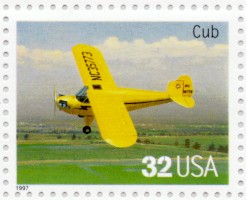Piper Cub
Today, a parable of technical longevity. The University of Houston's College of Engineering presents this series about the machines that make our civilization run, and the people whose ingenuity created them.
1963! My one flight in a Piper Cub. I taught in Eastern Washington. A colleague asked if I'd like to go for a spin. "Sure, I'd love to." So he loaded me into the second seat.
We set out over the Palouse wheat fields. We headed south, skimming 200 feet above what only can be described as amber waves of grain. Suddenly, the Snake River Canyon -- deepest in America. Earth tumbled away. We were a mile above ground.
"Okay, you've got the stick," he shouted. It was the only time I ever flew. He let me wander about the sky 'til we began side-slipping. He reclaimed control. We banked and turned and buzzed my house. By the end of an hour, I felt like a bird.
The Piper Cub is a wonder. It celebrated its 60th birthday in 1991. It's changed some over the years. But the original plane looks almost like a modern one. Both have the same broad high wing, the same short triangular landing gear strut, and the same yellow paint!
Gilbert Taylor and his brother Gordon began work on the Cub in 1928. Gordon died when an early version crashed. Then the depression put Gilbert at the brink of bankruptcy. That's when Bill Piper, a Pennsylvania oilman, bought the company. He kept Gilbert Taylor on as chief engineer.
They offered the first Piper Cub to the public in 1931. It cost $1325. Some thought it would be the new Model-T of the sky -- cheap mass transportation. In the end, of course, individual airplanes never did serve the masses.
But the Piper Cub was such a safe, solid, elementary piece of machinery that it became an American staple. It was the Army's liaison plane in WW-II. Eisenhower flew his own Cub. The Army called its version the Grasshopper.
Today the price of the Cub is higher. It's $60,000. You can also buy the Cub as a kit and build it yourself. The kit costs only $20,000, but you have to provide the engine.
The Cub's insides have changed some. It performs better nowadays. The first Cub cruised at 62 mph. Now it cruises at 115. It has 4 times the horsepower, half again the ceiling, and 2½ times the range. But it's the same plane.
Not even the DC-3 has been around as long as the Piper Cub. The Cub is an ageless airplane. The design is so clean and simple that it doesn't invite alteration. For me it's a lesson in life. The prototype flew a few days after I was born. It has stayed young by adapting -- by tumbling and turning in the sky without losing its essential simplicity. And that is what you and I must learn to do, as well.
I'm John Lienhard, at the University of Houston, where we're interested in the way inventive minds work.
(Theme music)
Siuru, B., The Piper Cub: Simplicity Takes Flight and Endures. Mechanical Engineering, November 1990, pp. 48-52.
Just for the record, I actually made two Piper Cub flights. I've combined them into one for rhetorical purposes.
